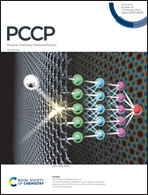Transmembrane potential in vesicles formed by catanionic surfactant mixtures in an aqueous salt solution†
Abstract
The transmembrane potential plays a key role in a multitude of natural and synthetic systems because it is the driving force for the flow of mobile charged species across the membranes. We develop a molecular thermodynamic theory to study the transmembrane potential of metastable and equilibrium vesicles as a function of the vesicle structural parameters, and salinity and acidity of the surrounding aqueous solution. We show that addition of salt to the external solution may reverse the sign of the transmembrane potential, indicating the reversal of sign of the net charges accumulated in the vesicle interior and exterior. We discuss maxima/minima of the transmembrane potential as a function of added salt and propose a simple formula to estimate the location of these extrema. We demonstrate that a vesicle brought to equilibrium with an acidic environment may take up and hold alkaline solution in its interior. We also show that bending of a symmetrically charged planar membrane leads to a buildup of the transmembrane potential. The catanionic vesicles considered in this work are composed of a series of classical surfactants and model surfactants differing in their molecular structure. These vesicles may serve as a simple prototype for capsules formed by the amphiphilic membranes of a more complex structure, e.g., in nanoreactors or drug-delivery systems.



 Please wait while we load your content...
Please wait while we load your content...